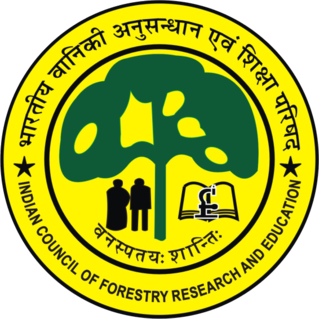
There are four categories of protected areas in India, constituted under the Wildlife Protection Act, 1972. Tiger reserves consist of areas under national parks and wildlife sanctuaries. There are 53 tiger reserves in India. As of January 2023, the protected areas of India cover 173,629.52 square kilometres (67,038.73 sq mi), roughly 5.28% of the total geographical area of the country.

The Indian Council of Forestry Research and Education (ICFRE) is an autonomous organisation or governmental agency under the MoEFCC, Government of India. Headquartered in Dehradun, its functions are to conduct forestry research; transfer the technologies developed to the states of India and other user agencies; and to impart forestry education. The council has 9 research institutes and 4 advanced centres to cater to the research needs of different bio-geographical regions. These are located at Dehradun, Shimla, Ranchi, Jorhat, Jabalpur, Jodhpur, Bengaluru, Coimbatore, Prayagraj, Chhindwara, Aizawl, Hyderabad and Agartala.

The Ministry of Environment, Forest and Climate Change (MoEFCC) is an Indian government ministry. The ministry portfolio is currently held by Bhupender Yadav, Union Minister of Environment, Forest and Climate Change.

Okhla Bird Sanctuary is a bird sanctuary at the Okhla barrage over Yamuna River. It is situated in Noida, Gautam Buddh Nagar district, on Delhi-Uttar Pradesh state border and known as a haven for over 300 bird species, especially waterbirds. In 1990, an area of 3.5 square kilometres (1.4 sq mi) on the river Yamuna was designated a bird sanctuary by the Government of Uttar Pradesh under the Wildlife Protection Act, 1972. The site is located at the point where the river enters Uttar Pradesh. The most prominent feature of the sanctuary is the large lake created by damming the river, which lies between Okhla village to the west and Gautam Budh Nagar to the east. The Okhla Bird Sanctuary (OBS) is roughly 4 square kilometres in size and is situated at the entrance of NOIDA in Gautam Budh Nagar district of Uttar Pradesh. It is situated at a point where river Yamuna enters in the state of Uttar Pradesh leaving the territory of Delhi. It is one among fifteen bird sanctuaries in the state.

Asola-Bhati Wildlife Sanctuary covering 32.71 km2 area on the Southern Delhi Ridge of Aravalli hill range on Delhi-Haryana border lies in Southern Delhi as well as northern parts of Faridabad and Gurugram districts of Haryana state. Biodiversity significance of Ridge lies in its merger with Indo-Gangetic plains, as it is the part of the Northern Aravalli leopard wildlife corridor, an important wildlife corridor which starts from the Sariska National Park in Rajasthan, passes through Nuh, Faridabad and Gurugram districts of Haryana and ends at Delhi Ridge.

The Western Ghats Ecology Expert Panel (WGEEP), also known as the Gadgil Commission after its chairman Madhav Gadgil, was an environmental research commission appointed by the Ministry of Environment and Forests of India. The commission submitted the report to the Government of India on 31 August 2011. The Expert Panel approached the project through a set of tasks, such as:
- Compilation of readily available information about Western Ghats
- Development of Geo-spatial database based on environmental sensitivity (Note: The geospatial datasets restored by OSGEO, contain critical GIS datasets from the WGEEP panel, including boundaries of critical wildlife corridors in the western ghats, biodiversity information, geo regions etc. The ESZ information was missing in the GIS datasets provided by OSGEO. Paani.Earth, a citizen led initiative for conservation of rivers has spatially mapped the ESZ taluks information provided in the WGEEP Report. While there may be errors, our goal is to make this information more accessible) and
- Consultation with Government bodies and Civil society groups.

Vanashakti is a non-profit environmental NGO based in Mumbai, Maharashtra. It was formed in 2006, by Meenakshi Menon, Namita Roy Ghose, and Peter Armand Menon. Vanashakti aims to conserve the forests, wetlands, wildlife corridors, habitats, through education and litigation to achieve its objectives of creating awareness about environmental topics, protecting and reviving rivers and preventing opencast mining in areas that are well-endowed with biodiversity. It also directs its efforts in involving local forest-dwelling communities to protect the biodiversity of the region and provides sustainable livelihood options for forest dependent and coastal communities. Vanashakti's thrust areas are forest, mangrove and wetland protection, environmental education for both urban and rural schools, livelihoods for forest based communities and scientific investigation into local environmental degradation.
Environment Protection Act, 1986 is an Act of the Parliament of India. It was enacted in May 1986 and came into force on 19 November 1986. It has 26 sections and 4 chapters. The Act is widely considered to have been a response to the Bhopal gas leak. The Act was passed by the Government of India under the Article 253 of the Constitution of India, which empowers to union government to enact laws to give effect to international agreements signed by the country. The purpose of the Act is to implement the decisions of the United Nations Conference on the Human Environment. They relate to the protection and improvement of the human environment and the prevention of hazards to human beings, other living creatures, plants and property. The Act is an “umbrella” legislation that has provided a framework for the environmental regulation regime in India, which covers all major industrial and infrastructure activities and prohibits and regulates specific activities in coastal areas and eco-sensitive areas. The Act also provides for coordination of the activities of various central and state authorities established under other environment-related laws, such as the Water Act and the Air Act.
Bir Shikargah Wildlife Sanctuary is situated in Panchkula district of Haryana state, India. It is spread over an area of 767.30 hectares. It also houses Vulture Conservation and Breeding Centre, Pinjore.
Khol Hi-Raitan Wildlife Sanctuary is situated in Panchkula district of Haryana State, India. It is 0.5 kilometres (0.31 mi) away from Panchkula on the Morni Road and its aerial distance from the Bir Shikargah Wildlife Sanctuary is only 3 kilometres (1.9 mi).
The Vindhyan Ecology and Natural History Foundation (VENHF) is a registered non-profit organisation (2012) with its headquarter in Mirzapur, Uttar Pradesh, India, working for the protection and conservation of the nature, natural resources and rights of the nature dependent communities in the ecologically fragile landscape of Vindhya Range in India. Vindhya Bachao Abhiyan is the flagship campaign of the organization.
The Kuldiha Wildlife Sanctuary is located at the Balasore district of Odisha, India. The sanctuary is spread across 272.75 km2 (105 sq mi) in the Chota Nagpur Plateau region. It is connected with Simlipal National Park via the Sukhupada and Nato hill ranges.
Kapilasa Wildlife Sanctuary or Kapilash Wildlife Sanctuary is situated in Dhenkanal district of Odisha state in India. It is spread across 125.5 km2 (48 sq mi) in the Chota Nagpur Plateau region. It is classified as an Eastern Highlands moist deciduous forests ecoregion.

Phulwari ki Nal Wildlife Sanctuary is in Udaipur District of Rajasthan, in the southern Aravalli Hills bordering the state of Gujarat, India. It was declared a Wildlife Sanctuary on 6 October 1983 by the Government of Rajasthan.
Gudekote Sloth Bear Sanctuary is located in Ballari district in Karnataka, India. It is spread over 38.48 km2 (14.86 sq mi). The sanctuary was created exclusively for the preservation of the Indian sloth bear and is Asia's second sloth bear sanctuary, the first being Daroji Sloth Bear Sanctuary.

Pant Wildlife Sanctuary is a wildlife sanctuary in India, situated near Rajgir in Nalanda district, Bihar, India. It is under the Nalanda forest division.
Talra Wildlife Sanctuary is located in Shimla, Himachal Pradesh, India. It became a wildlife sanctuary in the year 1962. This wildlife sanctuary covers an area of 40 km2. It is an eco-sensitive zone, notified by the Ministry of Environment, Forest and Climate Change (MOEFCC). It is home to Snow Leopard which is very rare in the region.

Ramadevarabetta Vulture Sanctuary is a bird sanctuary in Karnataka India, aimed for the protection of vultures. Established in 2012, it is the first Vulture Sanctuary in India. Of the nine vulture species found in India, three species, long-billed, Egyptian and white-backed vultures are found here. In 2018, Indian government tagged an area of 1.30 meters to 1.80 km from the boundary of the sanctuary as an eco-sensitive zone (ESZ). The total area of the eco-sensitive zone is 7.08 km2 (2.7 sq mi).

Rangayyanadurga Four–horned antelope Wildlife Sanctuary is a wildlife sanctuary in Karnataka India, aimed for the protection of Four-horned antelopes. The four-horned antelope is classified as Vulnerable species by the International Union for the Conservation of Nature and Natural Resources (IUCN). Established in 2011, it is the only four-horned antelope sanctuary in Karnataka.
Great Nicobar Development Plan is a planned mega-infrastructure project for the southern tip of Great Nicobar Island in Andaman Sea of India. The island comes under the Nicobar district administriation in the Indian union territory of Andaman and Nicobar Islands.











